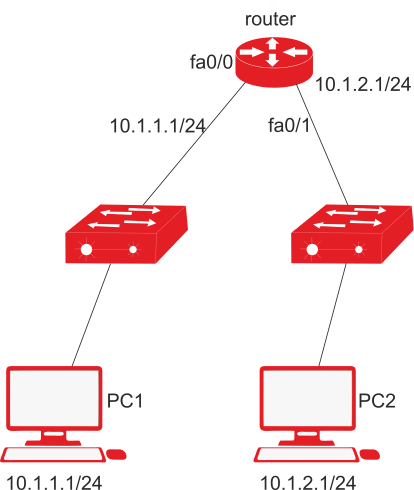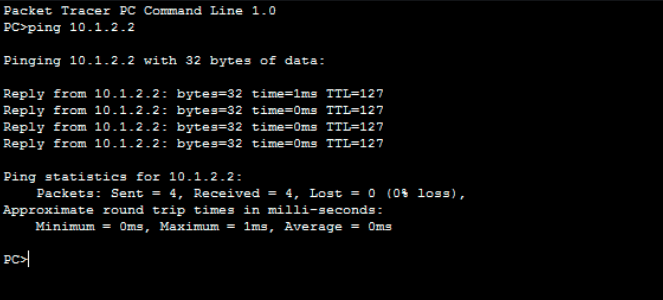Tutorial
Physical Layer
Data Link layer
Network Layer
Routing Algorithm
Transport Layer
Application Layer
Network Security
Misc
- Router
- OSI vs TCP/IP
- TCP vs UDP
- Transmission Control Protocol
- TCP port
- IPv4 vs IPv6
- ARP Packet Format
- ARP Table
- Working of ARP
- FTP Client
- FTP Commands
- FTP Server
- I2C Protocol
- Sliding Window Protocol
- SPI Protocol
- IP
- ARP Commands
- ARP
- Address Resolution Protocol
- ARP and its types
- TCP Retransmission
- CAN protocol
- HTTP Status Codes
- HTTP vs HTTPS
- RIP Protocol
- UDP Protocol
- ICMP Protocol
- MQTT protocol
- OSPF Protocol
- Stop and Wait Protocol
- IMAP Protocol
- POP Protocol
- CIFS
- DAS
- DIMM
- iSCSI
- NAS (Network Attached Storage)
- NFS
- NVMe
- SAN
- Border Gateway Protocol
- Go-Back-N ARQ
- RJ Cable
- Difference between Connection-Oriented and Connectionless Service
- CDMA vs. GSM
- What is MAC Address
- Modem vs. Router
- Switch Vs. Router
- USB 2.0 vs 3.0
- Difference between CSMA CA and CSMA CD
- Multiple access protocol- ALOHA, CSMA, CSMA/CA and CSMA/CD
- URI vs URL
- IMAP vs. POP3
- SSH Meaning| SSH Protocol
- UTP vs STP
- Status Code 400
- MIME Protocol
- IP address
- proxy server
- How to set up and use a proxy server
- network security
- WWW is based on which model
- Proxy Server List
- Fundamentals of Computer Networking
- IP Address Format and Table
- Bus topology and Ring topology
- Bus topology and Star topology
- Circuit Switching and Packet switching?
- Difference between star and ring topology
- Difference between Router and Bridge
- TCP Connection Termination
- Image Steganography
- Network Neutrality
- Onion Routing
- Adaptive security appliance (ASA) features
- Relabel-to-front Algorithm
- Types of Server Virtualization in Computer Network
- Access Lists (ACL)
- What is a proxy server and how does it work
- Digital Subscriber Line (DSL)
- Operating system based Virtualization
- Context based Access Control (CBAC)
- Cristian's Algorithm
- Service Set Identifier (SSID)
- Voice over Internet Protocol (VoIP)
- Challenge Response Authentication Mechanism (CRAM)
- Extended Access List
- Li-fi vs. Wi-fi
- Reflexive Access List
- Synchronous Optical Network (SONET)
- Wifi protected access (WPA)
- Wifi Protected Setup (WPS)
- Standard Access List
- Time Access List
- What is 3D Internet
- 4G Mobile Communication Technology
- Types of Wireless Transmission Media
- Best Computer Networking Courses
- Data Representation
- Network Criteria
- Classful vs Classless addressing
- Difference between BOOTP and RARP in Computer Networking
- What is AGP (Accelerated Graphics Port)
- Advantages and Disadvantages of Satellite Communication
- External IP Address
- Asynchronous Transfer Mode (ATM)
- Types of Authentication Protocols
- What is a CISCO Packet Tracer
- BOOTP work
- Subnetting in Computer Networks
- Mesh Topology Advantages and Disadvantages
- Ring Topology Advantages and Disadvantages
- Star Topology Advantages and Disadvantages
- Tree Topology Advantages and Disadvantages
- Zigbee Technology-The smart home protocol
- Network Layer in OSI Model
- Physical Layer in OSI Model
- Data Link Layer in OSI Model
- Internet explorer shortcut keys
- Network Layer Security | SSL Protocols
- Presentation Layer in OSI Model
- Session Layer in OSI Model
- SUBNET MASK
- Transport Layer Security | Secure Socket Layer (SSL) and SSL Architecture
- Functions, Advantages and Disadvantages of Network Layer
- Protocols in Noiseless and Noisy Channel
- Advantages and Disadvantages of Mesh Topology
- Cloud Networking - Managing and Optimizing Cloud-Based Networks
- Collision Domain and Broadcast Domain
- Count to Infinity Problem in Distance Vector Routing
- Difference Between Go-Back-N and Selective Repeat Protocol
- Difference between Stop and Wait, GoBackN, and Selective Repeat
- Network Function Virtualization (NFV): transforming Network Architecture with Virtualized Functions
- Network-Layer Security | IPSec Modes
- Next - Prev Network-Layer Security | IPSec Protocols and Services
- Ping vs Traceroute
- Software Defined Networking (SDN): Benefits and Challenges of Network Virtualization
- Software Defined Networking (SDN) vs. Network Function Virtualization (NFV)
- Virtual Circuits vs Datagram Networks
- BlueSmack Attack in Wireless Networks
- Bluesnarfing Attack in Wireless Networks
- Direct Sequence Spread Spectrum
- Warchalking in Wireless Networks
- WEP (Wired Equivalent Privacy)
- Wireless security encryption
- Wireless Security in an Enterprise
- Quantum Networking
- Network Automation
- Difference between MSS and MTU
- What is MTU
- Mesh Networks: A decentralized and Self-Organizing Approach to Networking
- What is Autonomous System
- What is MSS
- Cyber security & Software security
- Information security & Network security.
- Security Engineer & Security Architect
- Protection Methods for Network Security
- Trusted Systems in Network Security
- What are Authentication Tokens in Network security
- Cookies in Network Security
- Intruders in Network Security
- Network Security Toolkit (NST) in virtual box
- Pivoting-Moving Inside a Network
- Security Environment in Computer Networks
- Voice Biometric technique in Network Security
- Advantages and Disadvantages of Conventional Testing
- Difference between Kerberos and LDAP
- Cyber security and Information Security
- GraphQL Attacks and Security
- Application Layer in OSI Model
- Applications of Remote Sensing
- Seven Layers of IT Security
- What is Ad Hoc TCP
- What is Server Name Indication(SNI)
Time Access List
The principal application of an access-list is packet filtering. If one of the conditions matches, it is executed and no other condition is matched further. It is a sequential set of different permit or deny criteria. Additionally, it ends with an implicit denial, therefore the rules ought to have at least one permit condition.
Access-list types include
- Standard Access List
- Time-based Access list,
- Named Access list,
- Extended Access list, and
- Reflexive Access list.
But in this section, we'll talk about time-based access lists.

Time Access List -
Time-based access-lists are a particular kind of access-list that regulate network access according to time intervals. It is helpful when you wish to impose limitations on outbound or incoming traffic based on a specific time of day or specific days of the week.
For instance, let's say we wish to restrict Internet access during business hours but allowing it over lunch. We can use time-based access-lists to block access to the Internet in situations like these.
In Cisco IOS Software Release 12.0.1.T, time-based ACLs were introduced to enable access control based on the time. Although router clocks can be used, NTP (Network Time Protocol) synchronisation is recommended.
Working of Time Access List -
There is a simple procedure for using Time-based access-list:
- Define time-range - First, we must define a time-range, which can be specified using the keywords absolute or periodic.
- absolute: specifies a specific time. For instance, if we want to restrict ICMP traffic to a subnet from Tuesday to Friday (absolute time), we will use the absolute keyword.
- periodic: specifies a time interval. For instance, if we want to block ICMP on a specific subnet every weekday (Monday through Friday), we can use the periodic keyword.
- Define an access-list - In the next step, we will define an access-list to which we will apply our time-range.
- Apply an access-list to an interface - The access-list will now be applied to an interface or line-vty based on our requirements.
Configuration -
There is a simple topology consisting of PC1 (ip address 10.1.1.2/24), router (ip address 10.1.1.1/24 on fa0/0 and 10.1.2.1/24 on fa0/1), PC2 (ip address 10.1.2.2/24) and two switches, Sw1 and Sw2, with all ports in vlan 1. We can see that after configuring these, PC1 can ping PC2.

In this scenario, we will deny PC1 the ability to ping PC2 within the time-range specified, and then apply this time-range to an access-list. Finally, we will apply this to a router interface. Also, we know that it works best with NTP, but in this case, we will use the router's local clock.
We can view a router's clock by issuing the following command:
- router#show clock
We can also change the clock time with the following command:
- router#clock set 0:10:0 1 July 2018
Now, we'll define time-range by first specifying the time we want PC1 to be blocked in order for PC2 to ping PC1.
- router(config)#time-range time_flow
- router(config)#absolute start 00:15 1 July 2018
- end 00:20 1 July 2018
The name of time flow is time-range (any name can be given). We've given you the time range of 00:15 to 00:20 on July 1.
The use of an absolute keyword is demonstrated here.
If a scenario necessitates a periodic time span, it can be represented as:
- router(config)#time-range Periodic
- router(config)#periodic weekdays 0:15 to 0:20
Periodic is the name of the time-range in this case. The second command indicates that ping from 10.1.1.2 to 10.1.2.2 will be prohibited on all weekdays (Monday through Friday) from 0:15 to 0:20. (after we apply this time-range to an access-list and then applying access-list to an interface as described further).
Defining an extended access-list called Time acl that will allow ICMP traffic to pass through the router during the time-range we specify.
- router(config)#ip access-list extended Time_acl
- router(config-ext-nacl)#deny icmp host 10.1.1.1 host
- 10.1.2.2 time-range time_flow
Now, we'll apply this access-list to the router's outbound interface fa0/1 to deny traffic in the time-range (time flow) that we've defined.
- router(config)#int fa0/1
- router(config-if)#ip access-group Time_acl out
We will be unable to ping 10.1.2.2 within the timeframe we have set.
Benefits -
- Simple to implement
- It gives an administrator more control over traffic because it can be denied or permitted based on time.


